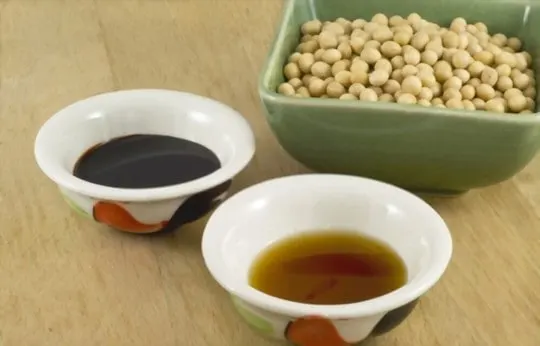Light soy sauce is a well-known condiment used in various dishes, including stir-fries and marinades.
But do you know how to best use light soy sauce, or what the best substitutes for light soy sauce are?
Whether you’re looking for an alternative to this flavorful sauce or simply want to know more about the different types of soy sauce available, learning truth behind these questions can be quite beneficial.
Understanding the nuances between dark and light soy sauces can bring a whole new level of flavor to your cooking.
Discovering the best alternatives will help ensure that nothing gets missed out on when this essential ingredient isn’t at hand.
What is Light Soy Sauce?

Light soy sauce, also referred to as “thin” soy sauce is a type of Chinese dark soy sauce that is much thinner and saltier than other varieties.
It is fermented for a shorter amount of time and has a salt to water ratio that is higher than other varieties, resulting in an intense flavor profile.
When used in Chinese cooking, light soy sauce provides the necessary saltiness that many dishes require without the presence of large amounts of sugar or molasses.
This type of soy sauce works best when added near the end or after cooking as it can quickly lose its flavor if boiled or simmered too long.
It can be used as an ingredient in marinades, dressings and gravies but also adds great depth of flavor when splashed into hot oil before anything else is added to the pan.
Light soy sauce works well with vegetables, Chinese noodles stir-fries, seafood dishes like Peking duck and in Cantonese cuisine for barbecues.
A few drops help bring out the flavor in meat skewers, dumplings and steamed fish dishes.
Non-Chinese dishes such as Malaysian Laksa soup or gluten free Pad Thai usually contain some degree of light soy sauce for their signature flavors too.
The 5 BEST Substitutes for Light Soy Sauce
Although it is easy to find light soy sauce in any store, substitute sauces can be used in place of it if you’re out of stock or if you simply want to try something different.
Here’s a detailed comparison of the 5 best substitutes for Light Soy Sauce, along with their key characteristics and proper ratios:
| Substitute | Key Characteristics | Proper Ratio |
|---|---|---|
| Tamari Sauce | Tamari sauce is a gluten-free alternative to soy sauce. It has a rich, savory flavor and a similar umami taste to light soy sauce. | Use an equal amount as Light Soy Sauce |
| Coconut Aminos | Coconut aminos is a soy-free alternative made from fermented coconut sap. It has a slightly sweet and salty flavor, similar to light soy sauce. | Use an equal amount as Light Soy Sauce |
| Miso Paste | Miso paste is a fermented soybean paste with a rich and savory flavor. It provides umami depth to dishes, making it a suitable substitute for light soy sauce. | Use half the amount of Light Soy Sauce |
| Worcestershire Sauce | Worcestershire sauce is a tangy and savory condiment made from fermented anchovies. While not identical in taste, it can add complexity to dishes like light soy sauce. | Use half the amount of Light Soy Sauce |
| Hoisin Sauce | Hoisin sauce is a thick and sweet Chinese sauce often used as a glaze or dipping sauce. It offers a different flavor profile but can add depth and sweetness to dishes requiring light soy sauce. | Use half the amount of Light Soy Sauce |
Now let’s explore each substitute in more detail:
1 – Tamari Sauce

Tamari sauce is a type of Japanese soy sauce that is thicker and richer than regular light soy sauce.
It also typically contains less wheat and is slightly more mellow in flavor than light soy sauce, making it an excellent substitute for people that are on a gluten-free diet.
Generally speaking, the flavor of tamari sauce will be deeper, so you’ll want to start off with less tamari in your dish than you would with light soy sauce.
However, it makes up for its more intense taste by giving you a greater depth of flavor and more umami.
Tamari also contains more salt than light soy sauce, so if you’re watching your sodium intake, you may want to consider one of the other options listed here as a healthier alternative.
2 – Coconut Aminos

Coconut aminos is a popular alternative to light soy sauce, made from the fermented sap of coconut flowers and sea salt.
It has a sweet and savory flavor that can be used as an all-purpose seasoning, stir-fries, salad dressings, marinades, dipping sauces and more.
It contains 17 amino acids essentially identical to those in light soy sauce and may provide health benefits similar to those of traditional soy sauce—but without the added gluten or GMO’s.
Coconut aminos can be found in natural food stores and online in bottles with a net weight of 8 ounces or more.
When substituting for light soy sauce in recipes, use half the amount called for; you may find that you need to adjust it further based on your preferences.
3 – Miso Paste

Miso paste – particularly white miso paste – is a great substitute for light soy sauce.
It is a fermented bean curd product and has a very mild flavor with “umami” characteristics.
As such, it provides the same salty flavor with slightly different nuances than soy sauce.
Miso paste is made from fermented soybeans, salt, and koji (a mold that helps break down starches into sugars).
The beans are then combined with other ingredients like rice or barley and allowed to ferment for anywhere from 6 months to 10 years.
This creates a thick, dark paste that can be mixed with water or other sauces to create an umami-rich condiment.
As a result of the fermentation process, it contains very few carbohydrates, making it ideal for those on Paleo and ketogenic diets as well as vegans or vegetarians.
4 – Worcestershire Sauce

Worcestershire sauce is a blend of vinegar, anchovies, tamarind, garlic and other spices.
It has a distinct umami taste that is unique to Worcestershire sauce and is difficult to replicate with other ingredients.
This makes it an excellent light soy sauce substitute in Asian-style dishes or marinades.
The flavor of Worcestershire sauce can be quite intense at first, so it’s best to start by using half the amount called for in a recipe that calls for light soy sauce.
Once you’ve determined the right ratio for your tastes, you can start adjusting accordingly.
Additionally, Worcestershire Sauce contains added sugar, so you may need to reduce the sweetness of your dish if using this substitute for light soy sauce.
As with all sauces and condiments, make sure that you account for any added salt before seasoning your dish further.
5 – Hoisin Sauce

Hoisin sauce is a dark reddish-brown condiment with a thick, syrupy consistency.
Popular in Chinese cuisine, it is made from fermented soybeans, garlic, chilies and various spices.
It often contains other ingredients like vinegar or sugar.
Hoisin sauce has a sweet and slightly pungent flavor that makes it unique among condiments.
It adds a distinct flavor to food and can be used as a dip for meat or vegetables.
It also works as an excellent base for marinades, stir fries or sauces.
As a lighter substitute for light soy sauce, hoisin provides the same umami flavors with less sodium.
The high sugar content of hoisin makes it not suitable for certain dishes where sweetness would be undesirable.
Conclusion
In conclusion, light soy sauce is an authentic, flavorful ingredient in many savory dishes.
It is specifically used to add a hint of saltiness and umami without making the dish too salty or overpowering its other flavors.
When it’s unavailable, using any of the substitutes listed above can produce comparable results.
However, it should also be noted that these replacements will not taste exactly like light soy sauce and may contain an undesired level of saltiness or unique flavor profiles.
As such, experimentation and adjusting their ratios to fit your intended dish may be necessary.

The 5 BEST Substitutes for Light Soy Sauce
Ingredients
- 1 – Tamari Sauce
- 2 – Coconut Aminos
- 3 – Miso Paste
- 4 – Worcestershire Sauce
- 5 – Hoisin Sauce
Instructions
- Choose your preferred substitute from the list of options.
- Organize all of your ingredients.
- Use the proper substitute to cook your recipes.
